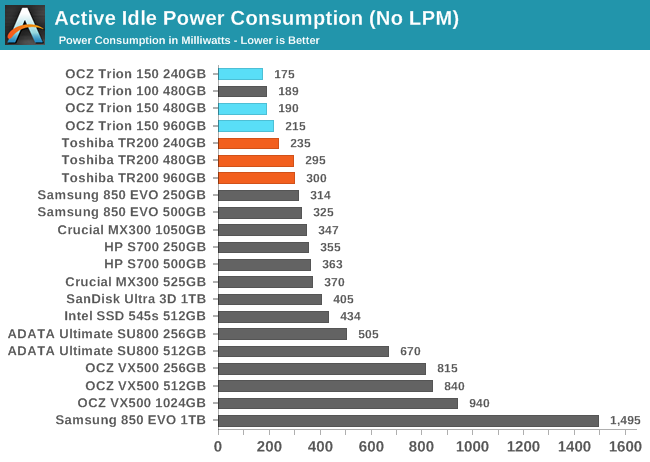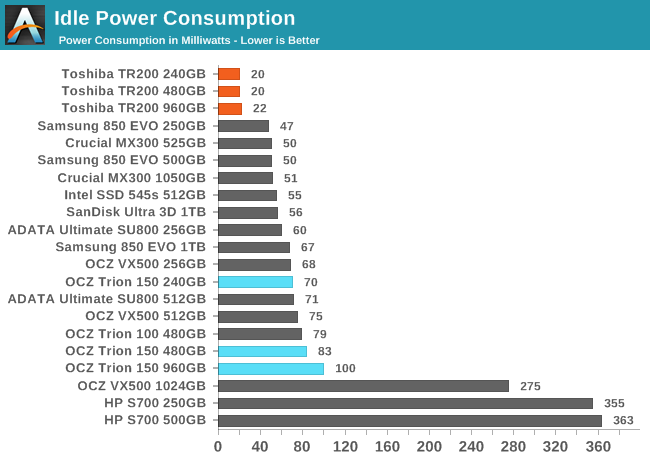The Toshiba TR200 3D NAND SSD Review: One Step Forward, One Step Back
by Billy Tallis on October 11, 2017 7:00 AM ESTPower Management
Real-world client storage workloads leave SSDs idle most of the time, so the active power measurements presented earlier in this review only account for a small part of what determines a drive's suitability for battery-powered use. Especially under light use, the power efficiency of a SSD is determined mostly be how well it can save power when idle.
SATA SSDs are tested with SATA link power management disabled to measure their active idle power draw, and with it enabled for the deeper idle power consumption score and the idle wake-up latency test. Our testbed, like any ordinary desktop system, cannot trigger the deepest DevSleep idle state.
Idle power management for NVMe SSDs is far more complicated than for SATA SSDs. NVMe SSDs can support several different idle power states, and through the Autonomous Power State Transition (APST) feature the operating system can set a drive's policy for when to drop down to a lower power state. There is typically a tradeoff in that lower-power states take longer to enter and wake up from, so the choice about what power states to use may differ for desktop and notebooks.
We report two idle power measurements. Active idle is representative of a typical desktop, where none of the advanced PCIe link or NVMe power saving features are enabled and the drive is immediately ready to process new commands. The idle power consumption metric is measured with PCIe Active State Power Management L1.2 state enabled and NVMe APST enabled.


Drives using the Phison S10 controller have usually been the clear winners in the active idle power consumption test but not quite competitive when the slumber state us activated. The S11 controller used by the TR200 seems to be a little less effective at saving power with slumber state disabled, but when it's enabled they set a new record and are just barely within the resolution of our meter.

The exceptional idle power management of the TR200 comes at the cost of a fairly high wake-up latency, about 2.4 milliseconds, more than twenty times as long as the TR150 takes to wake up.










50 Comments
View All Comments
r3loaded - Wednesday, October 11, 2017 - link
Pwned by an 850 Evo but only $10 cheaper. Yay what a surprise.ddriver - Wednesday, October 11, 2017 - link
Cudos to toshiba for making an ssd that is as slow in sequential writes as a mechanical hdd. I can't imagine it was easy.It's a serious contender for "lousiest sata ssd of 2017".
masouth - Wednesday, October 11, 2017 - link
of just 2017?takeshi7 - Wednesday, October 11, 2017 - link
correction: slower than an hdd in sequential writes. But then again a lot of these cheap TLC drives have lower sustained write speed than HDDs. What really amazes me is that Toshiba actually made an SSD that's worse than the Crucial BX200. I never thought that would be possible.Samus - Wednesday, October 11, 2017 - link
At 1/10th the power consumption though. As hard as it is to defend this drive, it’s clear toshiba had a very specific goal in mind with this drive: cheap upgrades for cheap laptops. As an OEM supplier for many vendors (including even Apple) this drive is adequate for many sub-$500 laptops: being dramless makes power loss protection mostly unnecessary as it will likely recover from sram loss inside the controller, as the indirection table is mirrored off then back to the nand after each write.However, I’ve never been a fan of dramless controllers. Seams like a mind boggling corner to cut when the cost of 512mb DDR3 is $4.
Lolimaster - Wednesday, October 11, 2017 - link
Fact is Crucial MX300 is as cheap and way better, my way way way better,Samus - Sunday, October 15, 2017 - link
I've long stood by that assertion. Crucial and Samsung SSD's are the only mainstream drives worth considering. Sure, Sandisk, Intel, even Mushkin have their niche products, but Samsung and Crucial have no real "duds."Flunk - Wednesday, October 11, 2017 - link
Has Anandtech reviewed another budget SSD that's competitive with the 850 Evo, seems like that's the gold standard at the moment. I just bought one for my Mom for Christmas.theramenman - Wednesday, October 11, 2017 - link
The SanDisk Ultra 3D they reviewed a bit ago gets similar performance to a 850 Evo for $43 less (at least for the 1TB version).sonny73n - Thursday, October 12, 2017 - link
3 most valued SSD models currently on Amazon. One of them is the BX300 with capacity max out at 480GB which I can only compare it to the similar of the other 2.- Samsung 850 Evo 500GB $160
- SanDisk Ultra 3D 500GB $170
- Crucial BX300 480GB $145
The first 2 are made of TLC NAND and the BX300 is made of MLC. No brainer to pick the best one here.